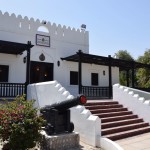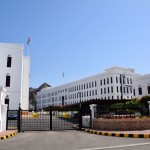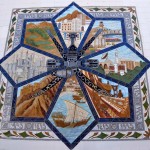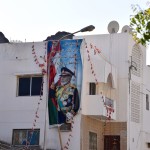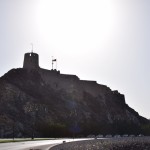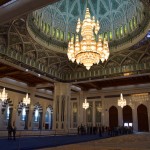Touring Oman in two days focusing on Muscat and the historic forts on the first stop of the trip, Perusing the Persian Gulf.
The Journey
Oman was the start of my Perusing the Persian Gulf tour which would bring me around the Persian Gulf towards Iran and finally Azerbaijan.
Coming from New York I had a 24 hour journey with two layovers in Milan and Doha before landing at Muscat’s international airport. Fortunately the immigration process was quite efficient with two banks processing visa payments and I was surprised to find that I could even use credit cards (6 rials ~ $15).
With a payment receipt in hand, I went up to the immigration counter and had my passport stamped without even a question. I officially entered country 120.
I headed to the Grand Hyatt Muscat where I would base my touring around the country. My primary focus were the sights of Muscat and the forts of Oman around the Djebel Akhdar highlands.
Overall Oman definitely gave me an “Oh Man” experience. Even though I knew it was safe, I was still a bit skeptical with the war raging in neighboring Yemen. I was surprised to find how friendly and modern the country was. In fact, when I was visiting the palace a group of young boys approached me. I was ready to fend off their begging, but instead ended up answering questions in English for their school project about water conservation. One of the kids even gave me a chocolate after. Roles reversed and somehow I became the beggar of delicious treats…
A full day is a decent amount of time to explore the main sights of Muscat especially if you have a car which is essential to visit the forts. On my first day, I explored the city by foot and taxi. I met a fellow traveler named Jerry who is also on a world adventure. We explore Muscat a bit and I headed to the airport with him so I could pick up a rental. The next day I completed touring Muscat by car, then headed to the forts a couple of hours away. After that I drove directly to the airport to catch my flight to Bahrain.
This is what I saw.
Muscat
Sultan’s Arms Museum
This war and military museum has an impressive collection of arms, uniforms, vehicles, boats, planes and history. Partially displayed within the 150 year-old Bait Al Falaj Fort, the museum is at the headquarters for the Armed Forces and can only be visited with a soldier in full camouflage uniform.
The Sultan’s old Cadillac limos with two-inch bulletproof glass were interesting to examine.
Muscat Old City
The oldest part of Muscat was a walled in city protected by forts. Now it is a quiet administrative and political center. Al Alam Palace of Sultan Qaboos in the old city is where ceremonies are held. Unfortunately visitors are not allowed, but the square in front allows for some great photo ops.
Around the palace are Mirani and Jalali Forts, built in the 16th century by the Portuguese. I wandered into a closed entrance of one only to discover that the fort was still being used as a military base. Oops.
Down the street across the palace is a roundabout where the National Museum is located. Unfortunately it was closed for renovations during my visit. Opened in 1978 it focuses on culture, historic relics and Omani ships.
Further along the main road towards the port is the city gate with the Muscat Gate Museum set on the top floor, for you gate aficionados.
Port Sultan Qaboos
Into the main port area was Riyam Park with a peculiar white dome on a hill and Mutra Fort. The fort offers great views, especially of the sultan’s mega yacht sitting modestly in port but unfortunately it is closed to visitors. From the road there is a path to the top of the mountain, but after climbing it, I’m quite sure it’s not meant for tourists.
One of the attractions of the port area is the souk. The large souk seems to be primarily directed towards tourists than residents. In fact, I ended up getting my Omani tourist shirt here.
Around the corner of the souk is the Bait Al Barandah Museum, also known as the House of Naseeb. This historic merchant house presents the history of Muscat starting from the earth’s geological formation. So the displays were a mishmash of science, dinosaur animatronics, relics, culture, and even art.
Sultan Qaboos Grand Mosque
The highlight of Muscat is the Grand Mosque and for good reason. This fairly new Mosque was built with Indian sandstone in the 90s and completed in 2001. Besides its stunning architecture, wide spaces and serene environment, the mosque has an impressive chandelier and the world’s second largest hand woven carpet. The carpet is 70 by 60 meters to cover the entire floor of the main hall and weighs 21 tonnes. The German-made chandelier hold the Guinness World Record for the largest and most complex crystal chandelier in the world. This masterpiece features 1,200 lights, 24 carat gold plating, and almost 1 million Swarovski crystals.
Though packed with camera toting tourists (guilty), the mosque was a pleasure to visit. One is free to explore the property and listen in on a tour. There are several rooms to explore including fountain rooms and even an Islamic center. I stopped in and was welcomed with kawha coffee and traditional dates. A man explained some of the principles of Islam and then gave me a Koran. Interestingly he made point to mention that ISIS is a disgrace and does not represent Islam.
A short drive from the Grand Mosque is Mohammed Al Ameen Mosque. Recently opened, the mosque is not as tourist-friendly, but a visit will reward you with great views and an up-close inspection of the alluring architecture.
The Royal Opera House Muscat
The city’s opera house, envisioned by the Sultan, attracts visitors and locals alike with its grand productions, shopping and dining venues. The architecture is also very particular and impressive. It can accommodate 1,100 people and includes a concert theatre, auditorium, and an art centre.
After my tour of Muscat, I spent my second day driving out to the highlands to see the less developed Djebel Akhdar highlands and historic forts. It was a decent drive south of the city on a highway littered with speed traps. Some drivers sped right through, while others slowed down, so it was difficult to judge how to navigate the traps. The scenery is quite picturesque with mountain ranges and small villages along the road.
Nizwa Fort
I eventually arrived in the town of Nizwa and found a road full of traffic and construction. I made my way to the center and to the fort.
Dating back to the 12th century, the current fort was built in the 1650s by the Imam Sultan Bin Saif Al Ya’rubi. The robust tower has thick walls and was built over a stream to be able to sustain itself during sieges.
Unfortunately I missed the opening times of the fort, so I could only explore its outer walls. I did find a gate door open, so I wandered in and even found some underground tunnel. This tiny crawlspace was dark, full of spiderwebs and obviously unfrequented, so I decided not to proceed.
Bahla Fort
A short drive on a sparse and dusty road got me to the UNESCO World Heritage Site of Bahla Fort. Built in the 13th – 14th centuries, the fort has a sandstone foundation with high adobe walls.
Circling the fort I found a typical Omani village where children played soccer on the dirt fields. Cars roared by kicking up dust and locals gawked at me as I stood there photographing the fort at sunset.
Jabreen Castle
On the drive back I noticed a sign for Jabreen Castle, so I took a turn off the main road and headed to this impromptu stop.
Built in 1670 this castle and palace was built by the Al Immam BilArab bin Sultan Al Y`aribi who now rests in a tomb by the entrance. Besides serving as a protective safe house during war, the castle also was a pillar for education and had many study rooms.
In two days, I could only skim the surface of Oman but the short visit left me with a lasting impression of a grand sultanate proud of its heritage, tradition, and advancement. I look forward to exploring this diverse country on another occasion.


